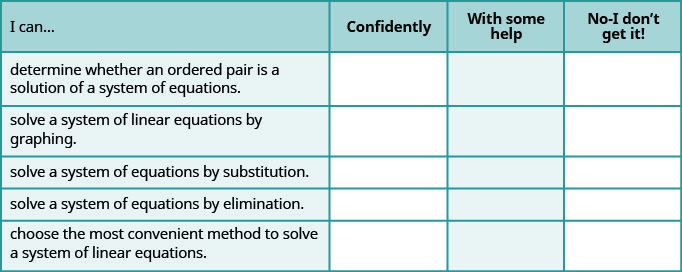4.2E: Exercises
( \newcommand{\kernel}{\mathrm{null}\,}\)
Practice Makes Perfect
Determine Whether an Ordered Pair is a Solution of a System of Equations
In the following exercises, determine if the following points are solutions to the given system of equations.
1. {2x−6y=03x−4y=5
ⓐ (3,1)
ⓑ (−3,4)
- Answer
-
ⓐ yes ⓑ no
2. {−3x+y=8−x+2y=−9
ⓐ (−5,−7)
ⓑ (−5,7)
3. {x+y=2y=34x
ⓐ (87,67)
ⓑ (1,34)
- Answer
-
ⓐ yes ⓑ no
4. {2x+3y=6y=23x+2
ⓐ (−6,2)
ⓑ (−3,4)
Solve a System of Linear Equations by Graphing
In the following exercises, solve the following systems of equations by graphing.
5. {3x+y=−32x+3y=5
- Answer
-
(−3,2)
6. {−x+y=22x+y=−4
7. {y=x+2y=−2x+2
- Answer
-
(0,2)
8. {y=x−2y=−3x+2
9. {y=32x+1y=−12x+5
- Answer
-
(2,4)
10. {y=23x−2y=−13x−5
11. {x+y=−4−x+2y=−2
- Answer
-
(−2,2)
12. {−x+3y=3x+3y=3
13. {−2x+3y=3x+3y=12
- Answer
-
(3,3)
14. {2x−y=42x+3y=12
15. {x+3y=−6y=−43x+4
- Answer
-
(6,−4)
16. {−x+2y=−6y=−12x−1
17. {−2x+4y=4y=12x
- Answer
-
no solution
18. {3x+5y=10y=−35x+1
19. {4x−3y=88x−6y=14
- Answer
-
no solution
20. {x+3y=4−2x−6y=3
21. {x=−3y+42x+6y=8
- Answer
-
infinite solutions with solution set: {(x,y)|2x+6y=8}
22. {4x=3y+78x−6y=14
23. {2x+y=6−8x−4y=−24
- Answer
-
infinite solutions with solution set: {(x,y)|2x+y=6}
24. {5x+2y=7−10x−4y=−14
Without graphing, determine the number of solutions and then classify the system of equations.
25. {y=23x+1−2x+3y=5
- Answer
-
1 point, consistent and independent
26. {y=32x+12x−3y=7
27. {5x+3y=42x−3y=5
- Answer
-
1 point, consistent and independent
28. {y=−12x+5x+2y=10
29. {5x−2y=10y=52x−5
- Answer
-
infinite solutions, consistent, dependent
Solve a System of Equations by Substitution
In the following exercises, solve the systems of equations by substitution.
30. {2x+y=−43x−2y=−6
31. {2x+y=−23x−y=7
- Answer
-
(1,−4)
32. {x−2y=−52x−3y=−4
33. {x−3y=−92x+5y=4
- Answer
-
(−3,2)
34. {5x−2y=−6y=3x+3
35. {−2x+2y=6y=−3x+1
- Answer
-
(−1/2,5/2)
36. {2x+5y=1y=13x−2
37. {3x+4y=1y=−25x+2
- Answer
-
(−5,4)
38. {2x+y=5x−2y=−15
39. {4x+y=10x−2y=−20
- Answer
-
(0,10)
40. {y=−2x−1y=−13x+4
41. {y=x−6y=−32x+4
- Answer
-
(4,−2)
42. {x=2y4x−8y=0
43. {2x−16y=8−x−8y=−4
- Answer
-
(4,0)
44. {y=78x+4−7x+8y=6
45. {y=−23x+52x+3y=11
- Answer
-
no solution
Solve a System of Equations by Elimination
In the following exercises, solve the systems of equations by elimination.
46. {5x+2y=2−3x−y=0
47. {6x−5y=−12x+y=13
- Answer
-
(4,5)
48. {2x−5y=73x−y=17
49. {5x−3y=−12x−y=2
- Answer
-
(7,12)
50. {3x−5y=−95x+2y=16
51. {4x−3y=32x+5y=−31
- Answer
-
(−3,−5)
52. {3x+8y=−32x+5y=−3
53. {11x+9y=−57x+5y=−1
- Answer
-
(2,−3)
54. {3x+8y=675x+3y=60
55. {2x+9y=−43x+13y=−7
- Answer
-
(−11,2)
56. {13x−y=−3x+52y=2
57. {x+12y=3215x−15y=3
- Answer
-
(6/−9,24/7)
58. {x+13y=−113x+12y=1
59. {13x−y=−323x+52y=3
- Answer
-
(−3,2)
60. {2x+y=36x+3y=9
61. {x−4y=−1−3x+12y=3
- Answer
-
infinitely many solutions with solution set: {(x,y)|x−4y=−1}
62. {−3x−y=86x+2y=−16
63. {4x+3y=220x+15y=10
- Answer
-
infinitely many solutions with solution set: {(x,y)|4x+3y=2}
Choose the Most Convenient Method to Solve a System of Linear Equations
In the following exercises, decide whether it would be more convenient to solve the system of equations by substitution or elimination.
64.
ⓐ {8x−15y=−326x+3y=−5
ⓑ {x=4y−34x−2y=−6
65.
ⓐ {y=7x−53x−2y=16
ⓑ {12x−5y=−423x+7y=−15
- Answer
-
ⓐ substitution ⓑ elimination
66.
ⓐ {y=4x+95x−2y=−21
ⓑ {9x−4y=243x+5y=−14
67.
ⓐ {14x−15y=−307x+2y=10
ⓑ {x=9y−112x−7y=−27
- Answer
-
ⓐ elimination ⓑ substitution
Writing Exercises
68. In a system of linear equations, the two equations have the same intercepts. Describe the possible solutions to the system.
69. Solve the system of equations by substitution and explain all your steps in words: {3x+y=12x=y−8
- Answer
-
Answers will vary.
70. Solve the system of equations by elimination and explain all your steps in words: {5x+4y=102x=3y+27
71. Solve the system of equations {x+y=10x−y=6
ⓐ by graphing ⓑ by substitution
ⓒ Which method do you prefer? Why?
- Answer
-
Answers will vary.
Self Check
After completing the exercises, use this checklist to evaluate your mastery of the objectives of this section.

If most of your checks were:
…confidently. Congratulations! You have achieved the objectives in this section. Reflect on the study skills you used so that you can continue to use them. What did you do to become confident of your ability to do these things? Be specific.
…with some help. This must be addressed quickly because topics you do not master become potholes in your road to success. In math every topic builds upon previous work. It is important to make sure you have a strong foundation before you move on. Who can you ask for help? Your fellow classmates and instructor are good resources. Is there a place on campus where math tutors are available? Can your study skills be improved?
…no - I don’t get it! This is a warning sign and you must not ignore it. You should get help right away or you will quickly be overwhelmed. See your instructor as soon as you can to discuss your situation. Together you can come up with a plan to get you the help you need.


